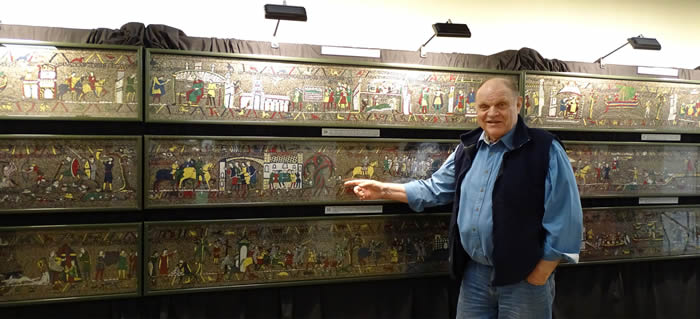Charlie Haylock had seen an exhibition, when he was on holiday in Oxfordshire – a mosaic replica of the Bayeux Tapestry. It is the most stunning exhibition Charlie had ever seen, both from an historical point of view, and as an absolute artistic masterpiece.

As soon as Charlie saw it, he asked as to when the exhibition would be going to Suffolk and East Anglia. He was told that it was not being displayed anywhere near East Anglia. But Charlie recognised the importance of the mosaic replica, and decided he would try and get the exhibition to come to Suffolk – and he has.
With help from BBC Radio Suffolk and the East Anglian Daily Times, a plea was put out to find a venue in a very short time span. The Mayor of Woodbridge, Clare Perkins responded, and along with James Lightfoot, Choose Woodbridge, the wheels were put in motion. A big Thank You goes to them all. Without them, the exhibition would not be in Suffolk.
The Medieval Mosaic Exhibition has now started in Unit 2, Riduna Park, Station Road, Melton, nr Woodbridge, IP12 1RT. Wednesday to Sunday (not open Mondays and Tuesdays), from 10am to 4pm till March 4th 2018. During half-term, it will also be open on Monday 12th and Tuesday 13th of February.
The mosaic is made up of 35 panels, each one 6' in length totalling 210' overall and weighs 55 stone (64 metres and 350 kg).
It was made by a New Zealander, Michael A. Linton,from the little bits of metal broken off from pattern discs in industrial knitting machines. It is made up of over three million pieces and taken 33 years in the making and in the Guinness Book of Records.
The Bayeux Tapestry itself is not the complete article; but the mosaic depicts the full story of 1066 and includes those panels missing from the Bayeux Tapestry including William's coronation on Christmas Day, 1066.
Suffolk was affected by the Normans just as anywhere else and sometimes, in an unexpected way.
Flempton near Bury St Edmunds is so called because William thanked some of the Flemish army leaders who joined him on The Conquest, and gave them some land. In the Domesday Book it's recorded as Flemingtuna - the farmstead settlement tuna of the Flemings.
Likewise, land in Suffolk and Essex around Haverhill was given to the leader of the Breton mercenaries, Helion the Breton, hence Helions Bumpstead. The Suffolk surname Hillen can be traced directly to Helion.
The Normans actually introduced the system of hereditary surnames,
and whilst the majority of the English population converted their bynames and nicknames into surnames, a number of Norman surnames entered the system including some peculiar to Suffolk. Some examples being Bloomfield (from Blonville sur Mer), Bullett (nickname for someone who is little and round boule – ett), Cordle (cordel, a chord maker), Durrant (durant, obstinate) and Garrod (Norman-French nickname for a warrior - brave spear).
Helion the Breton also brought superior mounted troops with him who were considered worthy of being on a horse. These were called Wiumarch, from which the predominantly Stour Valley surname Whymark derives.
The Suffolk dialect word absy for a boil derives from the Norman-French abcés (pronounced absay), normally anglicised to abscess.
The Normans built castles - as did their cousins that followed, up to and including the House of Anjou - the last one being King John
Some of these castles were built here in Suffolk, Eye Castle, Bungay Castle, Clare Castle, Orford Castle and the one that Ed Sheering composed a song about, Framlingham.
The Normans compiled two Domesday Books; the Little Domesday Book for East Anglia and Essex, as it was the most densely populated area and needed more clerics to compile it - and the Great Domesday Book for the rest of the country
Richard Fitz Gilbert was the first Lord of Ipswich according to the Domesday Book and a kinsman of William I and accompanied the Conqueror in 1066
Clare Castle was built by the de Clare family, who were descended from Richard Fitz Gilbert.
In 1066, St Gregory's Church, Sudbury belonged to Earl Morcar. He and his brother Edwin were major players in the Battle of Fulford which is part of the new section to the mosaic.